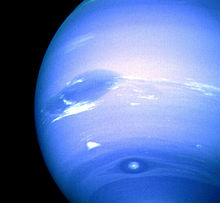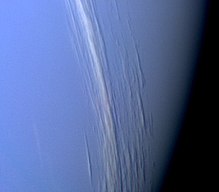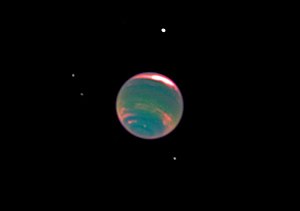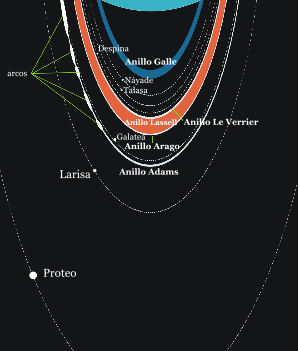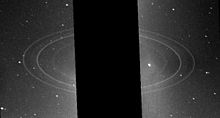Neptune (planet)
Neptune is the eighth planet in distance from the Sun and the farthest in the solar system. It is part of the so-called outer planets, and within these, it is one of the ice giants, and it is the first to be discovered thanks to mathematical predictions. Its name was put in honor of the Roman god of the sea —Neptune—, and it is the fourth planet in diameter and the third largest in mass. Its mass is seventeen times that of Earth and slightly greater than that of its "twin" planet Uranus, which is fifteen Earth masses and not as dense. On average, Neptune orbits the Sun at a distance of 30.1 au. His astronomical symbol is ♆, a stylized version of the god Neptune's trident.
After the discovery of Uranus, it was observed that the orbits of Uranus, Saturn, and Jupiter did not behave as predicted by Kepler's and Newton's laws. Adams and Le Verrier independently calculated the position of a hypothetical planet, Neptune, which was finally found by Galle on September 23, 1846, to be less than one degree from the position calculated by Le Verrier. Later it was found that Galileo had already observed Neptune in 1612, but had mistaken it for a star.
Neptune is a dynamic planet, with spots reminiscent of Jupiter's storms. The largest, the Great Dark Spot, was about the size of Earth, but in 1994 it disappeared and another one has formed. The strongest winds of any planet in the solar system are found on Neptune.
Neptune has a composition quite similar to that of the planet Uranus, and both have compositions that differ greatly from the other gas giants, Jupiter and Saturn. Neptune's atmosphere, like those of Jupiter and Saturn, consists mainly of hydrogen and helium, along with traces of hydrocarbons and possibly nitrogen. Contains a higher proportion of ice, such as water (H
2O), ammonia (NH
3) and methane ( CH
4). Scientists often categorize Uranus and Neptune as ice giants to emphasize the distinction between them and the gas giants Jupiter and Saturn. Neptune's interior, like Uranus's, is composed primarily of ice and rock. Methane traces in the outer peripheral regions contribute to the vivid blue appearance of this planet.
History
Discovery
Galileo's drawings show that the planet Neptune was first observed on December 28, 1612, and again on January 27, 1613; on both occasions, Galileo mistook Neptune for a star close to Jupiter in the sky. nocturnal.
In 1821, Alexis Bouvard published the orbit of Uranus in his astronomical tables. The observations revealed substantial disturbances, which led Bouvard to hypothesize that Uranus's orbit must be being perturbed by some other body. In 1843, John Couch Adams calculated the orbit of an eighth planet based on observed anomalies in the orbit of Uranus. He sent his calculations to sir George Airy, the Astronomer Royal, who asked for more information. Adams began to draft a response, but never got around to sending it. Urbain Le Verrier, the mathematician co-discoverer of Neptune, in 1846, independently of Adams, published his own calculations. In the same year, John Herschel began to advocate the mathematical approach and persuaded James Challis to search for Le Verrier's proposed planet. After much delay, Challis reluctantly began a search for it in July 1846. In the meantime, however, Le Verrier had convinced Johann Gottfried Galle to search for the planet. Neptune was discovered that same night, September 23, 1846, where Le Verrier had predicted it would be. Challis later realized that he had previously observed the planet twice in August, without realizing it.
In the aftermath of the discovery, there was much nationalist rivalry between the French and the British over who had priority and who deserved credit for the discovery. An international consensus eventually emerged that both Le Verrier and Adams jointly deserved credit. However, the issue is being reassessed by historians with the rediscovery, in 1998, of the Neptune Papers (historical papers from the Royal Observatory, Greenwich), which had reportedly been misappropriated by astronomer Olin Eggen for almost three decades and only rediscovered immediately after his death. After review of the documents, some historians indicate that Adams does not deserve equal credit with Le Verrier.
Name
Shortly after its discovery, Neptune was called, simply, "the planet that follows Uranus" or "the planet of Le Verrier." The first suggestion of a name came from Galle, who proposed the name Janus. In England, Challis introduced the name Ocean. In France, Le Verrier proposed that the new planet be named Le Verrier, a suggestion that was not well received outside of France.
Meanwhile, on separate and independent occasions, Adams proposed changing the name of Uranus to Georgia, while Le Verrier suggested Neptune for the new planet. Struve came out in favor of that name on December 29, 1846, at the Saint Petersburg Academy of Sciences. In Roman mythology, Neptune was the god of the sea, identified with the Greek Poseidon. The demand for a mythological name seemed to be in keeping with the nomenclature of the other planets, all of which were named after Roman deities.
The name of the planet literally translates to star of the sea king in Chinese, Korean, Japanese, and Vietnamese (海王星 in Chinese characters, 해왕성 in Korean).
In India, the name given to the planet is Varuna (Devanagari: वरुण), the god of the sea in Hindu/Vedic mythology, the equivalent of Poseidon/Neptune in Greco-Roman mythology.
Status
From its discovery until 1930, Neptune was the farthest known planet. With the discovery of Pluto in 1930, Neptune became the penultimate planet, save for 20 years between 1979 and 1999 when Pluto fell into its orbit. However, the discovery of the Kuiper belt in 1992 led many astronomers to debate. whether Pluto should be considered a planet in its own right or part of the larger belt structure. In 2006, the International Astronomical Union defined the word planet for the first time, reclassifying Pluto as a "dwarf planet" and redoing to Neptune, the last of the planets in the solar system.
First Year of Neptune
On July 12, 2011, after almost 165 Earth years, Neptune managed to complete its first full orbit around the Sun since its discovery in 1846, in what constitutes one year in terms of its own translation.
Physical characteristics
Composition and internal structure
Neptune's internal structure resembles that of Uranus: a rocky core covered by an icy crust, hidden under a thick, thick atmosphere. Neptune's inner two-thirds are composed of a mixture of molten rock, water, liquid ammonia and methane. The outer third is a hot gas mixture made up of hydrogen, helium, water and methane.
Like Uranus and unlike Jupiter and Saturn, Neptune's internal structure is thought to be made up of distinct layers. The upper layer consists of clouds of hydrogen, helium, and methane, which transform from gas to ice as depth increases. The mantle surrounds a compact core of rock and ice.
Its atmosphere comprises about 5-10% of its mass and probably extends from the planet's surface to depths corresponding to 10-20% of the distance to the core. At those depths, the atmosphere reaches pressures of about 10 GPa, or about 100,000 times that of Earth's atmosphere. Methane, ammonia, and water concentrations are increasing from the outer regions toward the lower regions of the atmosphere.
This mantle that surrounds the rocky core of Neptune is an extremely dense and hot region, it is believed that temperatures of 1700 °C to 4700 °C can be reached inside. It is a fluid with great electrical conductivity, it is a kind of ocean of water and ammonia.
At 7,000 km down, conditions cause methane to break down into diamond crystals that precipitate toward the core.
Atmosphere
Orbiting so far from the Sun, Neptune receives very little heat. Its surface temperature is −218 °C (55 K). However, the planet appears to have an internal source of heat. It is thought that it may be a remnant of the heat produced by the concretion of matter during its creation, which now slowly radiates heat into space. This source of internal heat produces very powerful weather systems around the planet, such as the Great Dark Spot that the Voyager 2 probe discovered as it passed through the Neptune system in 1989.
Another theory suggests that in the depths of Neptune the ideal conditions exist for carbon atoms to combine into crystals, releasing heat in the process. This hypothesis therefore raises the possibility that diamonds literally rain down on Neptune.
Neptune's color differs from Uranus's due to the slightly higher amount of helium contained in its atmosphere. Because of this, Neptune absorbs more red light from the Sun than its neighboring planet, so it reflects a much more intense blue.
Neptune's atmosphere has a banded structure similar to that found in the other gas giants. Phenomena such as giant hurricanes, with a diameter equal to that of Earth, and other cloud formations, including some extensive cirrus clouds, occur on this planet above (50 km) the main clouds. Thus Neptune has a very active cloud system, possibly more active than Jupiter's. Wind speeds in Neptune's atmosphere are up to 2,000 km/h, the highest in the solar system, and are believed to be fed by internal heat flow.
At high altitudes Neptune's atmosphere is 80% hydrogen and 19% helium. A small amount of methane is also present. There are prominent methane absorption bands at wavelengths above 600 nm in the red and infrared portion of the spectrum. As with Uranus, this absorption of red light by atmospheric methane is part of what gives Neptune its blue color, although Neptune's vivid blue is different from Uranus' cyan blue. Since Neptune's atmospheric methane content is similar to that of Uranus, some unknown atmospheric constituents are thought to contribute to Neptune's color.
Neptune's atmosphere is subdivided into two main regions: the lower region (troposphere), where temperature decreases with altitude, and the upper region (stratosphere), where temperature increases with altitude. The boundary between the two, the Neptunian tropopause, lies at a pressure of 10 kilopascals (0.1 bar). The stratosphere then gives way to the thermosphere at a lower pressure, between 1 and 10 Pa (10− 5 to 10−4 microbars). Higher up, the thermosphere gradually transitions to the exosphere.
Models suggest that Neptune's troposphere is divided by clouds into bands of different compositions depending on altitude. Upper level clouds are found at pressures below one bar, where the temperature is just right for methane to condense. For pressures between one and five bars (100 and 500 kPa), clouds of ammonia and hydrogen sulfide are thought to form. Above a pressure of five bars, the clouds can consist of ammonia, ammonium sulphide, hydrogen sulphide and water. Deeper clouds of water ice are believed to be found at pressures around 50 bar (5 MPa), where the temperature reaches 273 K (0 °C). Below are believed to be clouds of ammonia and hydrogen sulfide.
High altitude clouds have been observed on Neptune that cast their shadows on the opaque cloud layer below. There are also high altitude cloud bands that wrap around the planet at constant latitudes. These circumferential bands have widths of 50 to 150 km and are approximately 50 to 110 km above the cloud layer. These altitudes correspond to the layer where weather and climate events occur, in the troposphere. These phenomena do not occur at higher altitudes, which correspond to the stratosphere and thermosphere. Neptune has a larger icy mantle than Uranus.
Neptune's electromagnetic spectra suggest that the lower stratosphere is hazy due to condensation of products of ultraviolet photolysis of methane, such as ethane (C
2H
6) and acetylene (C
2H
2). The stratosphere also has small amounts of carbon monoxide (CO) and hydrogen cyanide (HCN). Neptune's stratosphere is hotter than Uranus's, due to the high concentration of hydrocarbons. The abundance of methane, ethane, and acetylene at Neptune's equator is 10 to 100 times greater than at the poles.
The planet's thermosphere has an abnormally high temperature of about 750 K. The planet is too far from the Sun for this heat to be generated by ultraviolet radiation. One of the candidates for a heating mechanism is atmospheric interaction with ions in the planet's magnetic field. Other possible explanations for this occurrence are gravity waves from within that dissipate into the atmosphere. The thermosphere contains traces of carbon dioxide (CO
2) and water, which may have been deposited at from external sources, such as meteorites or cosmic dust.
Magnetosphere
Neptune's magnetic field, like Uranus's, is quite tilted, 47° to the axis of rotation and offset by at least 0.55 radii (about 13,500 km ) of the physical center. Comparing the magnetic fields of the planets, the researchers think that the extreme orientation could be characteristic of the flows in the interior of the planet and not the result of the tilt of the planet itself or of any possible reversal of the fields on both planets. This field can be generated by fluid convective motions in a thin spherical shell of electrically conductive liquids (probably a combination of ammonia, methane, and water) resulting in dynamo action.
The dipole of the magnetic field, at Neptune's magnetic equator, is about 14 microtesla (0.14 G). Neptune's magnetic dipole moment is about 2,2x1017;T-m³ (14 μTRN³, where RN is the radius of Neptune). Neptune's magnetic field has a complex geometry, including relatively large contributions from non-dipole components, including a quadrupole moment that can exceed the strength of the dipole moment. By contrast, Earth, Jupiter, and Saturn have only relatively small quadrupole moments, and their fields are less tilted about the polar axis. Neptune's large quadrupole moment may be the result of displacement relative to the planet's center and the geometric limitations of the magnetic field-generating dynamo.
Neptune's bow shock, where the magnetosphere begins to slow down the solar wind, occurs at a distance of 34.9 times the radius of the planet. The magnetopause, where the pressure of the magnetosphere counteracts the solar wind, is between 23 and 26.5 times the radius of Neptune. The tail of the magnetosphere extends to at least 72 Neptune radii, and probably much further.
Climate
Neptune's weather is characterized by highly dynamic storm systems, with winds reaching speeds of nearly 600 m/s (2,200 km/h), nearing supersonic flow speeds. More typically, by tracking the For the movement of persistent clouds, wind speeds have been shown to vary from 20 m/s in the easterly direction to 325 m/s to the west. At the top of the clouds, the speed of the prevailing winds ranges from 400 m/s along the equator and 250 m/s at the poles. Most of the winds on Neptune move in a direction opposite to the planet's rotation. The general pattern of winds shows forward rotation at high latitudes against backward rotation at lower latitudes. The difference in flow direction is thought to be due to "skin effect" and not due to any deeper atmospheric process. At 70° S latitude, a high velocity jet travels at a speed of 300 m /s.
Neptune differs from Uranus in its typical level of weather activity. Voyager 2 observed weather events on Neptune during its 1989 flyby, but did not observe comparable events on Uranus during its 1986 flyby.
In 2007, the upper troposphere of Neptune's south pole was found to be about 10 K hotter than the rest of the planet, which averages about 73 K (−200 °C). The temperature difference is enough for methane, which freezes elsewhere in the troposphere, to escape into the stratosphere near the pole. This hotter region is due to the tilt of Neptune's axis, which has exposed the south pole. to the Sun during the last quarter of the Neptune year, or about 40 Earth years. As Neptune slowly moves to the opposite side of the Sun, the south pole will darken and the north pole brighten, causing methane release to shift to the north pole.
Due to seasonal changes, cloud bands in Neptune's southern hemisphere have been observed to increase in size and albedo. This trend was first seen in 1980 and is expected to last until around 2020. The long orbital period makes the seasons on Neptune last for forty years.
The exploration of Neptune: the rediscovery
The Voyager 2 spacecraft was launched 16 days before its twin, Voyager 1. The trajectory it followed was slower than that of its companion, in order to explore not only Jupiter and Saturn, but to continue the mission to Uranus and even Neptune. In order to reach all four planets, Voyager 2 required a launch that would give it all the thrust that the Titan III rocket was capable of. And while the rocket that ejected Voyager 1 didn't get a good launch, the one for Voyager 2 worked perfectly. Had the first rocket been used for Voyager 2, the spacecraft would not have reached Uranus and Neptune. Fortunately Voyager 2 had the better rocket.
When Voyager 2 arrived at Neptune on August 25, 1989 at 3:56 Greenwich Mean Time, one hundred and forty-three years after its discovery, little was known about this planet. The farthest of the four "giant planets" is thirty times further from the Sun than Earth and takes 165 years to go around the Sun. Its diameter is about four times larger than that of our planet. Two moons were known, including Triton, one of the most interesting objects in the solar system, and it was suspected that it might have rings. The data collected in a few hours by Voyager 2 gave us more information than nearly a century and a half of astronomical observations from Earth.
To the surprise of scientists, Voyager 2 revealed a large dark spot, similar to the red spot on Jupiter. It is a gigantic hurricane with winds of two thousand kilometers per hour, the most violent in our solar system. On Earth, the energy that produces the winds is supplied by the Sun. In the case of Neptune, currently the farthest planet from the Sun, the temperature at the top of the cloud cover is −210 °C, so solar energy is insufficient to drive the winds observed by Voyager 2. The planet appears to be continuing the process of contraction from which it was formed, a process that provides enough energy to generate these powerful winds. However, the general structure of the winds on Neptune has not been understood by scientists.
Some observations from Earth had provided evidence of rings around Neptune. This evidence was not conclusive since it seemed that more than rings it was about pieces of rings, like thin arcs of matter revolving around Neptune. Voyager 2 found four complete rings, two of them thin and the other two wide. The thin rings lie close to the orbit of two satellites believed to be responsible for their stability, and are therefore called "shepherd moons." The two widest rings are made of extremely opaque material that reflects approximately one ten thousandth of the light that falls on them, making them impossible to detect from Earth. The justification that the rings contain a large amount of dust can only be explained if a significant number of meteorites were housed in the neighborhood of Neptune, greater than in the innermost areas of the solar system.
For more than a century, only one moon of Neptune, called Triton, was known. In 1949 Gerard Kuiper discovered a second satellite, Nereid, which rotates very far from the planet. As in previous Voyager spacecraft encounters with other planets, Neptune had more "hiding" satellites. Voyager 2 discovered six new moons, including Despina and Galatea, the two shepherd moons mentioned above. Proteus, the largest of the "new moons," has a surface completely covered in craters, the largest of which is nearly half the size of Proteus itself. Despite these findings, Triton, Neptune's largest moon, and the one that has been known for over a century, remains the most interesting. Triton is a unique object in the solar system that well deserves a separate story.
Satellites of Neptune
Currently, there are fourteen known satellites of Neptune. The largest of these is Triton, which has more than 99.5% of the mass in orbit around Neptune in its 2,700 km diameter. It stands out, not only for its large size, but also for having a retrograde orbit, something exceptional among large satellites. Nitrogen geysers have been found on its surface. It has a spherical shape, while the other satellites of Neptune have an irregular shape.
Triton is considered a Kuiper Belt object captured by Neptune's gravity. Due to its size and appearance, it should be very similar to Pluto, now reclassified as a dwarf planet, which is also a Kuiper Belt object. Nereid, with 340 km in diameter, has the most eccentric orbit of all the satellites in the solar system, its distance from Neptune varies between 1,353,600 and 9,623,700 km.
Before the arrival of the Voyager 2 space probe in 1989, only these two satellites were known from observations from Earth: Triton and Nereid. Voyager 2 discovered six more: Naiad, Thalassa, Despina, Galatea, Larissa, and Proteus. These six satellites are the closest to the planet and have an orbit deeper than that of Triton. Most of the discovered satellites are less than 200 km in diameter and could be remnants of the previous moon that was destroyed or disintegrated during Triton's capture. Proteus is the largest with 400 km in diameter.
After that, five more small moons have been discovered (by telescopic surveys) between 2002 and 2003, located in orbits far from the planet, which have received the names Halimedes, Sao, Laomedeia, Psámate and Neso. All of them have highly inclined orbits and three have a retrograde orbit. Both characteristics, equal to those of Triton, suggest that its origin was also that of Kuiper Belt objects captured by Neptune's gravity.
On July 16, 2013, the discovery of moon number 14, provisionally named 'S/2004 N 1' now known as Hippocampus.
Newt
It is the largest satellite of Neptune, and the coldest in the solar system that has been observed by a Probe (−235 °C). Triton's Polar cap has geysers that spew nitrogen snow.
It was discovered by William Lassell on October 10, 1846, and is named after the god Triton of Greek mythology. It has a diameter of 2,707 km, which makes it the largest satellite of Neptune and the seventh in the solar system, as well as being the only large moon that has a retrograde orbit, that is, an orbit whose direction is opposite to the rotation of the planet. Because of its retrograde orbit and its composition, similar to that of Pluto, Triton is considered to have been captured from the Kuiper Belt by Neptune's gravitational pull.
Triton consists of a crust of frozen nitrogen over a mantle of ice which is believed to cover a solid core of rock and metal. It is one of the few satellites in the solar system known to be geologically active. Due to this activity, its surface is relatively young, and reveals a complex geological history from mysterious and intricate cryovolcanic and tectonic terrains. After the passage of the space probe Voyager 2 through its vicinity, some enigmatic images revealed what appeared to be geysers of liquid nitrogen emanating from its icy surface. This discovery changed the classical concept of volcanism since, until then, it was assumed that icy bodies should not be geologically active.
Triton has a tenuous nitrogen atmosphere with small amounts of methane. The Voyager 2 probe managed to observe a thin layer of clouds that form at the poles and are composed of nitrogen ice; there is also photochemical smog up to a height of 30 km that is composed of various hydrocarbons, similar to those found on Titan.
The surface temperature is −235 °C, even lower than Pluto's average temperature (about −229 °C); in fact it is the lowest temperature ever measured in the solar system.
Neptune's Rings
Neptune has a faint ring system, which is more similar to the Jupiter system than to the complex rings found on the planets Uranus and Saturn. These rings are formed by particles of ice and silicates as well as organic compounds, produced by radiation from the magnetosphere, so their color is very dark. The three main rings are the narrow and outermost Adams ring, 63,000 km away. from the center of Neptune, the Le Verrier ring, at 53,000 km, and the Galle ring, the widest of the three, at 42,000 km. In addition to these sharp rings there is a sheet of extremely tenuous material that extends from the Le Verrier ring to the Galle ring and probably further inland towards Neptune.
The first of these rings was discovered in 1968, although the results of these observations were not published until 1977, when the rings of Uranus were detected. But it was the space probe Voyager 2 that confirmed the existence of the rings as it passed Neptune in 1989. Images taken by Voyager 2 in 1989 also showed a large number of thin rings, from the outermost, which contains five prominent arcs, called Courage, Liberty, Equality 1, Equality 2 and Fraternity. These arcs could be formed by the gravitational influence of Galatea, one of Neptune's satellites.
Neptune's rings, like Uranus's, are thought to be relatively young. Their age is likely to be significantly younger than that of the solar system. Likewise, both are probably caused by the fragmentation and subsequent collision of the remains of one or more of Neptune's inner satellites. These fragments act as sources of dust and ring material. In this respect Neptune's rings are similar to the dust lanes observed by Voyager 2 between the main rings of Uranus.
The latest observations made from Earth show that Neptune's rings are much more unstable than previously thought, some parts have deteriorated dramatically. In 2002 and 2003, Imke de Pater of the University of California, Berkeley, and his colleagues used the Keck 10-meter telescope in Hawaii to take another look at the ring. They have already analyzed the images and found that all of the arcs appear to have disintegrated, while one in particular, called Liberty, has faded considerably since Voyager's observations. If this trend continues, Liberty will be gone within 100 years.
The results suggest that whatever is causing the arches to deteriorate is acting faster than any mechanism that could regenerate them, as the system appears to be out of balance.
Observation
This planet requires some searching. To locate it, you must use specific location charts or software capable of displaying Neptune along with a background of stars. You may come across binoculars if you know where to look. Like Jupiter and Saturn, it is a gaseous planet, but being much further from the Sun and Earth, its brightness is not very high and its atmospheric characteristics are not appreciable with amateur telescopes.
The best time to observe Neptune is near opposition. However, it can be observed with more or less difficulty from a few months before to a few months after. To know if it is visible or not at a certain moment, a planisphere can be used to determine if the constellation of Capricorn is on the horizon.
Finally, it should be noted that, due to Neptune's position with respect to Earth, observers from the Southern Hemisphere are favored, since in the North the planet is very low above the horizon.
How to locate it
Neptune is invisible to the naked eye, and its apparent size is so small that under low magnification—which is necessary when looking for an object—it's so tiny it looks like a star. For this reason, in order to locate it, it is necessary to use one of the two methods that have been described in the deep sky section:
- By using graduate circles: in this case it is necessary to know what the coordinates of Neptune are at the time of observation. The ephemeris should be consulted, preferably through the use of a computer programme.
- Using location maps. They are usually published in the journals. In order for them to be valid for a relatively high time interval, the line is drawn that follows when performing their orbit, and on it marks are made in the positions it occupies every few days (e.g. every two weeks).
Fonts
References
Contenido relacionado
Astronomical unit
Aquarius (constellation)
Rick Husband


